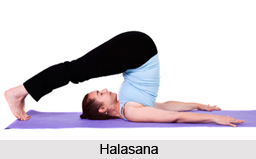 Halasana is a cultural asana deriving its name from Hala, meaning `plough` in Sanskrit, and alleivates the symptoms of backacke, headache, insomnia and sinusitis. The posture was first described in the Shri Tattva Nidhi, though under a different name, and is practiced widely amongst contemporary yoga students.
Halasana is a cultural asana deriving its name from Hala, meaning `plough` in Sanskrit, and alleivates the symptoms of backacke, headache, insomnia and sinusitis. The posture was first described in the Shri Tattva Nidhi, though under a different name, and is practiced widely amongst contemporary yoga students.
Meaning of Halasana
Halasana translates to the `plough pose` in Sanskrit and is called as such because the final position of the body in this posture resembles the shape of a plough.
Yoga Texts and Halasana
* A posture more or less identical to the Halasana was first described in the Shri Tattva Nidhi, a 19th century iconographic Hindu treatise compiled in the princely state of Mysore, Karnataka. The classic text refers to this posture as the Langalasana.
Practice Halasana
A sequential process for performing Halasana follows:
* Take supine position hands straight by the side of thighs, palm resting on the ground.
* Slowly raise your legs together without bending at knees by pressing your hands and stop at 30 degree angle.
* After few seconds raise your legs further up to 60 degree angle and maintain.
* Now slowly bring the legs at 90 degree angle.
* Pressing both the hands bring the legs little towards the head.
* Continue the bending of legs till toes touch the ground and then stretch your legs backward as far as possible.
* Now place both the palms on the head making finger lock. Bring the elbows on the ground.
* While returning back to the original position first release the finger-lock. Stretch the hands straight and place them on the ground by the side of the body.
* Lower the waist and raise the legs from the ground. Slowly let the waist rest on the ground and stop bringing the legs at 90 degree angle.
* Slowly come back to the original position.
Effects of Halasana
* If there is a complaint of Dyspepsia or constipation, it can be corrected by the practice of this Asana.
* The practice of this Asana is also useful in certain types of diabetes.
* Calms the brain.
* Stimulates the abdominal organs and the thyroid gland.
* Stretches the shoulders and spine.
* Helps relieve the symptoms of menopause.
* Reduces stress and fatigue.
* Therapeutic for backache, headache, infertility, insomnia, sinusitis.
* Since the spine is stretched fully in a curve, it becomes more elastic and its overall functioning is improved.
* All the muscles from toes to waist are also stretched helping improvement in the functioning of veins.
* This asana is also useful for gastric troubles, digestion problems.
Precautions for the practice of Halasana:
* Do not bend legs at the knees while raising them up.
* Do not jerk the legs while raising them.
* After reaching the angle of 90 go ahead carefully balancing your weight. Sometimes due to gravitational force, the legs may fall backward on the ground with jerk; therefore, one should exercise control.
* While stretching the legs backward balance one`s weight on the hands and also while returning use hands for balancing the weight.
* Do not forcibly stretch legs if they are not in a position to touch the ground. Stretch them as far as they are stretched easily. Maintain it. Gradual practice will make body capable of moving forward and flexibility will be developed.
* People suffering from spleen and lever complaints should do this asana after consulting Yoga expert.
* Those suffering from cervical spondylitis or stiffness in spine should practice it very carefully.
* Do not bend the legs in knees.
* Do not move the neck or overstrain it in chin lock position.
In this pose, there is a tendency to overstretch the neck by pulling the shoulders too far away from the ears. While the tops of the shoulders should push down into the support, they should be lifted slightly toward the ears to keep the back of the neck and throat soft. Open the sternum by firming the shoulder blades against the back.
Despite being an arguably recent addition to the asana compendium, the Halasana`s numerous beneficial effects have rendered it one of the most common asanas in contemporary yogic practice.




















